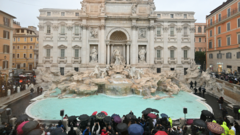Rome's treasured Trevi Fountain is set to shine brighter following its recent reopening after an extensive three-month restoration. Originally constructed in the 18th Century by architect Nicola Salvi on the façade of the Poli Palace, this baroque masterpiece has long been a major attraction, drawing between 10,000 and 12,000 visitors daily.
To ensure a more pleasant experience for those looking to admire its grandeur, the city has introduced a new queueing system aimed at preventing overcrowding around the iconic fountain. Mayor Roberto Gualtieri addressed the public during the reopening ceremony, stating that the limit on visitor numbers "will allow everyone to better enjoy the fountain, without crowds or confusion."
In addition to the queue management, Gualtieri hinted at possible plans to introduce a small entry fee to aid in the fountain's maintenance. The ceremony was attended by hundreds of tourists, many of whom embraced the tradition of tossing a coin into the revitalized waters, believing it will ensure their return to the Eternal City.
The fountain's restoration was not without cause; it became apparent in 2012 that its structural integrity was at risk, leading to significant renovations after the harsh winter. This recent cleaning project involved removing unsightly mould and calcium deposits, with the city keen on presenting its attractions ahead of the Catholic Church's jubilee celebrations starting on Christmas Eve.
The Trevi Fountain, commissioned by Pope Clement XII in 1730, marks the end point of the ancient aqueduct that once supplied water to Rome, the Acqua Vergine, flowing for an impressive 20 kilometers. The fountain's nearby tap allows visitors to drink from its historic waters, which is believed to have originated at the very site discovered by Roman soldiers in 19 BC, guided by a young virgin—a tale from which its name, 'Virgin Waters,' derives.
From legends to cinematic nods, like Frank Sinatra's iconic song, the tradition of tossing coins into the fountain persists, with local authorities once collecting around €10,000 (£8,300; $10,500) weekly, the proceeds of which supported a charity providing meals for those in need. The Trevi Fountain, now restored and better organized, promises a more enjoyable experience for future visitors to Rome.


















